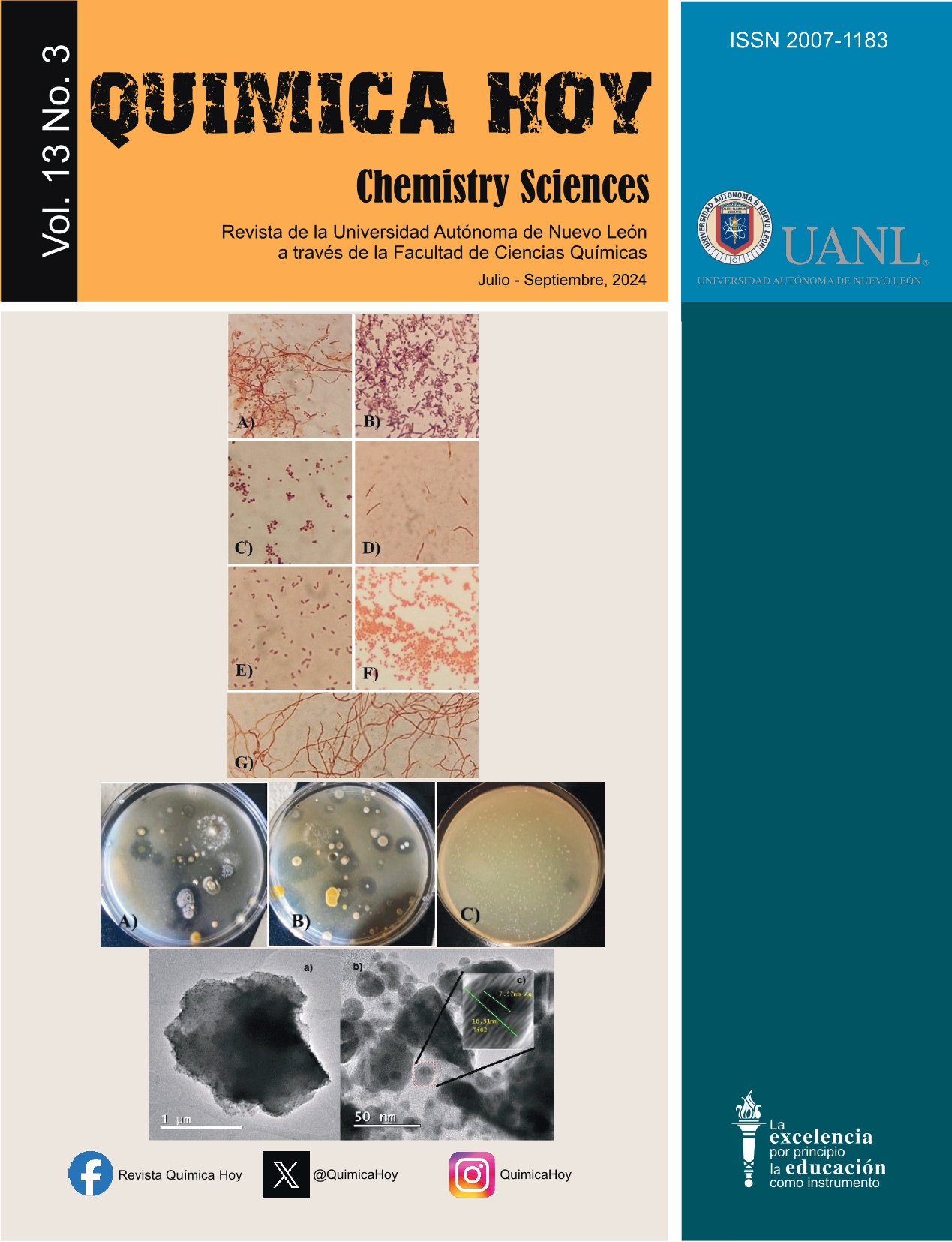Propiedades estructurales de un Nanomaterial con nanopartículas de AgTiO2 soportadas en arcillas de suelo natural y material reciclado
DOI:
https://doi.org/10.29105/qh13.03-437Palabras clave:
Suelo, Nanomateriales, Remediación ambiental, Nano remediación, Material recicladoResumen
Hoy en día, la síntesis de nanopartículas a partir de materiales naturales es importante para la recuperación del medio
ambiente. Estos materiales son baratos, reciclables y no requieren el uso de sustancias químicas tóxicas. En esta
investigación, se desarrolló un nanomaterial compuesto por nanopartículas(NP) de TiO2(TiO2-NP) y nanopartículas de Ag
(Ag-NP), arcillas de suelo natural y material reciclado se sintetizó en un único paso mediante un método térmico y
calcinación. En la síntesis se utilizó un suelo Vertisol de Guanajuato, México. La fase de Ag-NP, TiO2-NP,y arcillas de
suelos naturales se analizaron a partir de difracción de rayos X (DRX). La composición química de Ag, Ti y Si se demostró
mediante resultados de SEM y STEM. También se demostró que las Ag-NP estaban dispersas en la superficie de TiO2
(anatasa) y luego impregnadas en nanopartículas naturales del suelo para construir un nanomaterial. Los nanomateriales
compuestos de Ag-NP, TiO2-NP, NP de un suelo Vertisol y material reciclado mostraron su potencial para el desarrollo de
un material eficiente para remediación medioambiental, especialmente para el tratamiento del agua potable.
Descargas
Citas
- [1]. WHO and UNICEF, “Progress on Drinking Water, Sanitation and Hygiene,” World Health Organization, 2017, doi:10.111/tmi.12329.
- [2]. I. Ali and V. K. Gupta, “Advances in watertreatment by adsorption technology,” Nature Protocols, vol. 1, no. 6, pp. 2661—2667, 2007, doi.10.1038/nprot.2006.370. DOI: https://doi.org/10.1038/nprot.2006.370
- [3]. M. Keulemans, S. W. Verbruggen, B. Hauchecorne, J. A. Martens, and S. Lenaerts, “Activity versus selectivity in photocatalysis: Morphological or electronic properties tipping the scale,” Journalof Catalysis, vol. 344, no. 2016, pp.221—228, 2016, doi: 10.1016/j.jcat.2016.09.033. DOI: https://doi.org/10.1016/j.jcat.2016.09.033
- [4]. J. Wehling etal., “Silver nanoparticle-dopedzirconia capillaries for enhancedbacterial filtration, ”Materials Science and Engineering C, 2015, dot:10.1016/j.msec.2014.12.001. DOI: https://doi.org/10.1016/j.msec.2014.12.001
- [5]. L. Qi, Z. Liu, N. Wang, andY.Hu,“Facile and efficient in situ synthesis of silver nanoparticles on diverse filtration membrane surfaces for antimicrobial performance,” Applied Surface Science, 2018, doi:10.1016/j.apsusc.2018.06.066. DOI: https://doi.org/10.1016/j.apsusc.2018.06.066
- [6]. M. Calabi-Floody etal., “Nanoclays froman Andisol: Extraction, properties and carbon stabilization,” Geoderma, vol. 161, no. 3-4, pp. 159—167, 2011, doi: 10.1016/j.geoderma.2010.12.013. DOI: https://doi.org/10.1016/j.geoderma.2010.12.013
- [7]. S. De Gisi, G. Lofrano, M. Grassi, and M. Notarnicola, “Characteristics and adsorption capacities of low-cost sorbents forwastewater treatment:A review,” Sustainable Materials and Technologies, vo1. 9, pp. 10-40, 2016, doi:10.1016/j.susmat.2016.06.002. DOI: https://doi.org/10.1016/j.susmat.2016.06.002
- [8]. D. M. Schwertfeger etal., “Extracting Metallic Nanoparticles from Soils for Quantitative Analysis: Method Development Using Engineered Silver Nanoparticles and SP-ICP-MS,” Analytical Chemistry, p.acs.anaIchem.6b04668, 2017, doi:10.1021/acs.analchem.6b04668. DOI: https://doi.org/10.1021/acs.analchem.6b04668
- [9]. D. S. Garcia-Zaleta etal., “Effect of Pd Addition on the Nanostructure and Properties of Pd/TiO<sub>2</sub> Catalysts for the Photocatalytic Degradation of 4-Chlorophenol,”Journal of Nano Research, 2014, doi:10.4028/www.scientific.net/JNanoR.28.9. DOI: https://doi.org/10.4028/www.scientific.net/JNanoR.28.9
- [10]. R. L. Gonzàlez, “Influence of phases content on Pt/TiO2 , Pd/ TiO2 catalysts for degradation of 4-chlorophenol at roomtemperature .,” Journal of Nanomaterials,vo1. 2016, 2016. DOI: https://doi.org/10.1155/2016/1805169
- [11]. S.León-Silva, F. Fernández-Luqueño, and F. López Valdez, “Silver Nanoparticles (AgNP) in the Environment:a ReviewofPotential Risks on Human and Environmental Health,” Water, Air,& Soil Pollution, vol. 227, no.9, p. 306, 2016, doi:10.1007/s11270-016-3022-9. DOI: https://doi.org/10.1007/s11270-016-3022-9
- [12]. P. Raveendran, J. Fu, and S. L. Wallen, “A simple and “‘green”’ method for the synthesis of Au, Ag, and Au—Agalloy nanoparticles,” 2005, doi:10.1039/b512540e. DOI: https://doi.org/10.1039/B512540E
- [13]. X. Zhang, H. Sun, S. Tan, J. Gao, Y. Fu,and Z. Liu, “Hydrothermal synthesis of Ag nanoparticles on the nanocellulose and their antibacterial study,” lnorganic Chemistry Communications, vol. 100, no. December2018, pp.44-50, 2019, doi:10.1010/j.inoche.2018.12.012. DOI: https://doi.org/10.1016/j.inoche.2018.12.012
- [14]. C. C. Otto and S. E. Haydel, “Exchangeable Ions Are Responsible for the ln Vitro Antibacterial Properties of Natural Clay Mixtures,” PLoS ONE, vol. 8, no. 5, pp. 1—9, 2013, doi:10.1371/journal.pone.0064068. DOI: https://doi.org/10.1371/journal.pone.0064068
- [15]. E. I. Unuabonah, C.G.Ugwuja, M. O. Omorogie, A. Adewuyi, and N. A. Oladoja, “Clays for Efficient Disinfection of Bacteria in Water,” Applied Clay Science, vol. 151, no. October 2017, pp.211-223, 2018, doi:10.1016/j.clay.2017.10.005. DOI: https://doi.org/10.1016/j.clay.2017.10.005
Descargas
Publicado
Cómo citar
Número
Sección
Licencia
Derechos de autor 2025 Vianey Urdapilleta Inchaurregui, María Verónica Estrella Suárez

Esta obra está bajo una licencia internacional Creative Commons Atribución 4.0.





